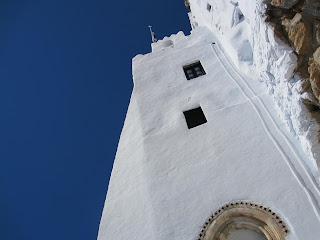The plan today was to visit the Byzantine monastery of Panagia Hozoviotissa on the other side of the island which we had almost visited on our previous stay in Katapola. I say almost because although we made the bus ride and climbed a mountain of steps to get there we fell foul of the strict dress code and weren’t allowed in on account of the fact that we were wearing shorts. This time we were taking no chances so packed extra long sleeved shirts, shawls and trousers and after breakfast on the terrace set off for the bus stop.
As we walked we passed an old islander on a mule and it was obvious that he was going about his day and his work on his chosen form of transport. I got to thinking about how infrequently you see this now, much less even than when I first started to visit the Greek islands over twenty-five years ago and I realised that soon this will be a thing of the past. When this generation has gone it is likely that no one will continue to use donkeys for anything other than equine amusement. I felt glad that I had been there in time to see this and felt disappointed for those who will come after me and won’t.
We arrived at the bus stop in time but we needn’t have bothered as there was no bus driver because he was working to his own version of GMT, that’s Greek Maybe Time, and we had to wait twenty minutes after the scheduled departure before he arrived for work and warmed up the engine and the hydraulics before easing out of the car park to begin the journey.
The bus dropped us off by the side of the road and there was a short walk to the car park of the monastery and then a gruelling climb up an uneven path which clung to the side of the mountain overlooking a stunning blue sea and which took us eventually to the entrance of the startling white building set against the contrast of the age streaked grey and tan rocks. The monastery is built in a most improbable location, on the side of and into an inhospitable mountain but it was a good choice if all they wanted was solitude and peace and quiet because there are no neighbours to worry about.
We were slightly irritated to see that this year there was a selection of clothing available to borrow for those who didn’t meet the dress code – it certainly wasn’t there two years ago. Anyway we changed into our appropriate clothes and climbed the final steps to the entrance where a young man assessed our appearance and, satisfied that we were presentable, allowed us in.
It had been a long walk just to visit a few tiny rooms and it didn’t take long to make our way through a couple of anti-chambers and then the main chapel smelling of incense and adorned with icons and pictures of old priests and decorated with cloth of vibrant green and blood red with gold brading. It was all over rather quickly and the longest part of the visit was a minute or two in room on the way out where a priest handed out loukoumi and a glass of special raki which was for sale in a small display case in the corner. Finally we visited a tiny museum displaying robes, manuscripts and religious artefacts and then we were shown back out into the sunlight and took the path back down to the bus stop.
On the way back we were ready for a second visit to the Chora where we ambled through the corkscrew streets returning several times to exactly the same place passing by several churches, the castle, blue doors, blue sky, shady vines and friendly cafés and I knew that this was my kind of town. The Chora is rather like a hippie time-warp, slow, lazy, faded and bleached, pot plants struggling in the midday sun and appropriately slow mood music in the tavernas and bars – it reminded me of a favourite pair of old denim jeans and my battered blue t-shirt that I am reluctant to throw away. In and around the tavernas there were lazy cats, which in between trying to look cute for diners with leftovers were concentrating on looking for a shady spot and simply snoozing the day away.




No comments:
Post a Comment